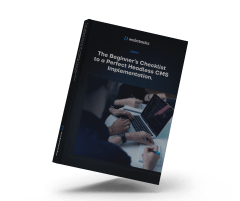Whether you're facing issues like high bounce rates or planning a redesign, this guide provides a practical, systematic approach to evaluate your website's UX and drive meaningful improvements. By focusing on data-driven insights and user behavior, you can transform your digital product into a more effective asset that aligns with both business goals and user needs.
In brief:
- A UX audit is a systematic evaluation that uses data-driven insights to identify user experience issues and improve satisfaction.
- Conducting a UX audit involves a six-step process, from setting objectives and evaluating your site to analyzing data and providing actionable recommendations.
- Essential tools for a UX audit include analytics platforms, behavior analysis tools, usability testing tools, and accessibility testing tools.
- Implementing findings from a UX audit can enhance user engagement, drive conversions, and align your product with both business goals and user needs.

Introduction to UX Audits
A UX audit is a systematic, data-driven evaluation of your digital product's user experience that employs empirical methods to identify issues and provide actionable recommendations for improvement. For fast-growing tech companies, these audits serve as a valuable diagnostic tool to enhance user satisfaction and drive conversions through evidence-based decisions rather than assumptions.
When your product faces challenges like declining engagement metrics, high bounce rates, or stagnating conversion rates, a UX audit can uncover the underlying issues preventing optimal performance. You should consider conducting an audit during key moments: when experiencing engagement lulls, before launching a minimum viable product (MVP), at the start of a redesign project, or when you've accumulated enough user data to analyze patterns and trends. A systematic approach helps ground your product decisions in user behavior data rather than speculation.
Preparation Phase
Before diving into your UX audit, proper preparation helps you gather meaningful insights rather than just surface-level observations. Start by defining clear, measurable objectives that align with both business goals and user needs. Your objectives should follow the SMART framework (Specific, Measurable, Achievable, Relevant, Time-bound) and connect directly to your organization's key performance indicators.
Next, identify and engage key stakeholders across different departments. Schedule individual interviews to understand their perspectives, pain points, and expectations from the audit. Cross-functional input helps create a comprehensive view of your current UX state and gains buy-in for implementing future recommendations.
Finally, establish a realistic timeline and resource allocation for your audit. Consider the scope of what you're analyzing and confirm you have access to necessary tools and team members. As Einstein notably suggested, spend more time understanding the problem than rushing to solutions—dedicate sufficient time for thorough analysis rather than quick fixes.
Create a project brief that includes:
- Audit objectives and success metrics
- List of stakeholders and their roles
- Timeline with key milestones
- Required resources and tools
- Current state assessment parameters
- Expected deliverables
Remember that a well-planned preparation phase sets the foundation for an effective UX audit that delivers actionable insights rather than just surface-level observations.
Conducting the UX Audit: A 6-Step Process
1. Set Up Your Audit Framework
Start by establishing clear objectives and gathering necessary resources. Define specific goals like improving retention rates or increasing conversions. Create a timeline—most UX audits take 2–4 weeks. Assemble your team, including designers, developers, and stakeholders. Build user personas and map customer journeys to guide your evaluation.
Consider incorporating emerging UX design trends to make sure your audit framework is up-to-date with the latest industry developments.
2. Perform Systematic Evaluation
Conduct a screen-by-screen analysis of your product, examining each interface element through the lens of your user personas. Use established frameworks like Nielsen Norman Group's usability heuristics to assess interface elements. Document issues using screenshots and detailed notes, categorizing problems by severity and impact on user experience. For instance, if your target users include busy professionals accessing your app on mobile devices, evaluate the ease of navigation and readability on smaller screens.
Addressing common UX design challenges during this phase can help you identify and resolve issues that may be hindering user engagement.
3. Analyze Quantitative Data
Deploy analytics platforms to gather concrete user behavior data. Use web analytics tools for traffic patterns and conversion rates. Implement heat mapping software to understand click patterns and user engagement. Track key metrics including:
- Bounce rates and exit points
- User flow patterns
- Time on page
- Conversion rates by segment
- Mobile vs. desktop usage
Pay special attention to high-impact pages like landing pages. Techniques for optimizing landing pages can significantly improve user retention and conversion rates.
Incorporating on-page SEO for UX can enhance visibility and improve user experience simultaneously.
4. Gather Qualitative Insights
Complement your quantitative data with user feedback. Conduct 5–10 user interviews focusing on key tasks and pain points. Use session recording tools to watch real user interactions with your product. Review customer support tickets and feedback to identify recurring issues. Such insights help you understand the "why" behind user behaviors identified in your quantitative analysis. For instance, repeated complaints about a specific feature can highlight areas requiring immediate attention.
Adhering to web accessibility best practices during this stage to make your product is accessible to all users, including those with disabilities. By addressing these insights, you can focus on improving conversion funnel with design, ensuring users move smoothly through your product's desired pathways.
5. Synthesize Your Findings
Aggregate data from all sources and identify patterns. Categorize issues based on impact and implementation effort. Create improvement hypotheses based on your research. Use a prioritization framework to rank issues—consider using a matrix that weighs user impact against implementation complexity.
Understanding how to improve CRO with UX design and drive conversions through UX can be instrumental in prioritizing changes that will enhance your conversion funnel.
6. Document and Present Results
Create a comprehensive UX audit report that includes:
- Executive summary of key findings
- Detailed analysis with supporting data
- Prioritized list of issues
- Specific, actionable recommendations
- Links to relevant data sources
Include visual evidence like screenshots, heat maps, and user flow diagrams to support your findings. When presenting to stakeholders, consider fintech website redesign tips if your product operates within that industry.
Remember that identifying issues is only the first step; the real value of the audit comes from providing actionable insights that drive meaningful improvements to your product's user experience.

Essential UX Audit Tools
To conduct a thorough UX audit, you'll need a combination of tools for different aspects of the evaluation process. Here's a curated selection of the most effective types of tools:
Analytics Tools
- Web analytics platforms: Track user behavior, traffic patterns, and conversion data.
Leveraging tools optimized for optimizing SEO for better UX can also enhance your product's search engine visibility.
Behavior Analysis Tools
- Heat mapping software: Provides heatmaps and session recordings to visualize user interactions.
Usability Testing Tools
- Remote user testing platforms: For gathering qualitative feedback from users interacting with your product.
Accessibility Testing Tools
- Web accessibility evaluation tools: Assess your product for compliance with accessibility standards.
Don't forget to utilize essential tools for UX audits to streamline your process and provide comprehensive coverage.
Most of these tools offer free tiers or trials, allowing you to test their capabilities before committing to a paid plan. For fast-growing tech companies, combining web analytics, heat mapping software, and remote user testing platforms provides a solid foundation for comprehensive UX audits.
Creating the UX Audit Report
After completing your UX audit analysis, compile your findings into a clear, actionable report. Start with an executive summary that outlines the key discoveries and their potential impact on business objectives. Follow this with your methodology section to establish credibility and context for your findings.
Incorporate SaaS UX design strategies to make your recommendations more effective if you're operating in the SaaS industry.
The core of your report should present key insights supported by visual evidence. Include screenshots, data visualizations, and user quotes to illustrate problems and opportunities. When documenting issues, prioritize them based on severity and potential impact on user experience.
Additionally, consider strategies to boost SaaS website traffic as part of your actionable recommendations.
Structure your recommendations as an actionable implementation plan. For each issue:
- Describe the problem clearly
- Provide specific, implementable solutions
- Include estimated effort and impact
- Assign responsible parties and deadlines
When presenting to stakeholders, focus on the most impactful insights rather than listing every minor issue. Frame your findings constructively, emphasizing opportunities for improvement rather than criticizing current solutions. Support your recommendations with data and user feedback to build a compelling case for change.
Remember to maintain a balance between detail and clarity. While comprehensive documentation is important, your report should be accessible and actionable for all stakeholders involved in implementing the changes.
Implementation and Follow-up
After completing your UX audit, create a detailed implementation roadmap that prioritizes improvements based on impact and effort. Start with quick wins to build momentum while planning for more substantial changes. Assign clear responsibilities and timelines to each task to maintain accountability.
Adopting headless CMS benefits can streamline your content management and deployment during this phase.
Execute improvements iteratively rather than attempting a complete overhaul at once. For example, a company might begin by addressing critical navigation issues identified in their UX audit, leading to an immediate increase in user engagement. By prioritizing high-impact changes, you can see immediate results while planning for more extensive updates.
To validate the effectiveness of your improvements, establish a measurement framework. Monitor key metrics through analytics, conduct follow-up usability testing, and gather user feedback to verify that changes are achieving desired outcomes. Use A/B testing when possible to compare the performance of new designs against existing ones.
Remember that UX improvement is an ongoing process. Consider implementing periodic mini-audits to maintain momentum and catch new issues early. Such a continuous improvement approach helps your digital product evolve with user needs and expectations.
Our Take on How to Perform a UX Audit
At Webstacks, we've seen firsthand how a well-executed UX audit can transform a digital product's performance. By systematically evaluating user interactions and leveraging data-driven insights, companies can uncover hidden issues that impede user satisfaction and conversion rates.
Our experience confirms that investing time in thorough preparation and using the right mix of analytical and qualitative tools leads to actionable recommendations that align with both business objectives and user needs. Implementing these insights iteratively enhances the user experience and drives measurable business growth, reinforcing the value of a strategic approach to UX auditing.

Conclusion
Conducting a UX audit is a strategic process that enables tech companies to enhance their digital products by aligning them more closely with user needs and business goals. By following a systematic approach—setting clear objectives, evaluating user data, and implementing actionable recommendations—you can significantly improve user satisfaction and drive conversions. Remember that UX auditing is not a one-time task but an ongoing practice that helps your product evolve alongside your users' expectations. With the right preparation and tools, a UX audit can be a catalyst for meaningful improvements and sustained digital success.
Ready to optimize your SaaS website structure for growth? See the Webstacks difference: Schedule a brief discovery call today. Let us help you create a website that drives results.




